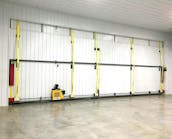NATA Releases Fire Marshal Toolkit and Accidental Foam Discharge Checklist
Today, the National Air Transportation Association (NATA) released the Fire Marshal Toolkit and Accidental Foam Discharge Checklist as part of its Hangar Foam Fire Suppression System Initiative. An educational resource for Fire Marshals, FBO owners, and operators, the Toolkit provides vital information facilitating hangar design and construction conversations and highlighting research and frequency data on inadvertent hangar foam fire suppression system discharges.
This free online resource provides information on FBO operations and includes detailed information on factors impacting the decision to use foam fire suppression in hangars, including:
- Aviation fuels
- Types of foam
- Aircraft hangar fire protection regulations
- Possible environmental issues from foam
- Causes of unwanted foam discharges
- Insurance considerations
The Toolkit outlines NATA’s proposed changes to NFPA 409 – Standard on Aircraft Hangars; and with inadvertent foam discharges occurring almost once per month on average, The So You’ve Had an Accidental Foam Discharge, Now What? checklist provides critical guidance on what should or should not be done following a hangar foam system discharge.
“NATA members have noted that hangar foam systems provide very little risk mitigation due to the very low incidence of hangar fuel fires while dramatically increasing the cost of new hangar development – assertions that have been confirmed by a 2019 University of Maryland research study,” stated NATA President & CEO Timothy Obitts. “As part of our initiative to reduce the requirements for foam systems in aircraft hangars, we wanted to assist the industry by developing a resource guide for interacting with local fire officials during new hangar construction.”
“Until changes to the NFPA 409 standard are made, this resource will serve as a guide to help educate local fire marshals and hangar developers on the safety and environmental risks, as well as the potential of aircraft damage related to accidental discharges of hangar foam suppression systems,” added Megan Eisenstein, NATA’s Director of Regulatory Affairs.
NATA would like to thank Fisher Engineering for its assistance in the development of the Toolkit and for those NATA members and nonmembers who graciously donated their expertise and financial support of the initiative. For more information about NATA's Hangar Foam Fire Suppression System Initiative, please visit www.nata.aero/advocacy/foam.


